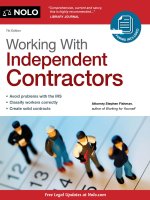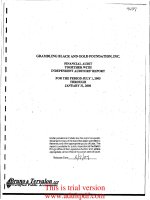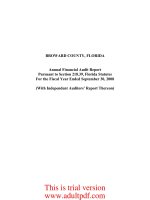Punctuation marks with independent clauses
Bạn đang xem bản rút gọn của tài liệu. Xem và tải ngay bản đầy đủ của tài liệu tại đây (8.06 KB, 1 trang )
Punctuation marks with independent clauses
Independent clauses can be separated (or connected) in a variety of ways.
Full stop
When both clauses are of equal importance and can stand on their own, we usually use a full stop to separate
them.
My toddler refuses to take a nap in the afternoon. He thinks he will miss out on some of the action.
Here the two clauses are separated with a full stop because they express complete thoughts and can stand on
their own.
Comma + coordinating conjunction
Sometimes we use a comma and a coordinating conjunction.
My toddler refuses to take a nap in the afternoon, and I’m afraid that he will soon drive me crazy.
Here the two independent clauses are connected with a conjunction and separated with a comma.
By using a semicolon
In situations where you use a semicolon, you can use a full stop as well. The semicolon is preferred when the
independent clauses are too closely related.
In spite of staying up all day, my toddler refuses to go to bed early; he thinks he will miss something.
We can also use a transitional adverb to establish the connection between two independent clauses. Note that a
transitional adverb (e.g. therefore, in addition, moreover, as a result etc.) does not connect the two clauses. It
merely shows the flow of ideas.
My toddler kept me awake all night; as a result, I don’t feel very well.
Instead of the semicolon, we can use a full stop here.
My toddler kept me up all night. As a result, I don’t feel very well.
Don’t forget to put a comma after the transitional verb. Also note that a transitional adverb that follows a
semicolon begins with a small letter.
Stay on top of your writing! Download our grammar guide from www.englishgrammar.org to stay up-to-date.
Powered by TCPDF (www.tcpdf.org)









